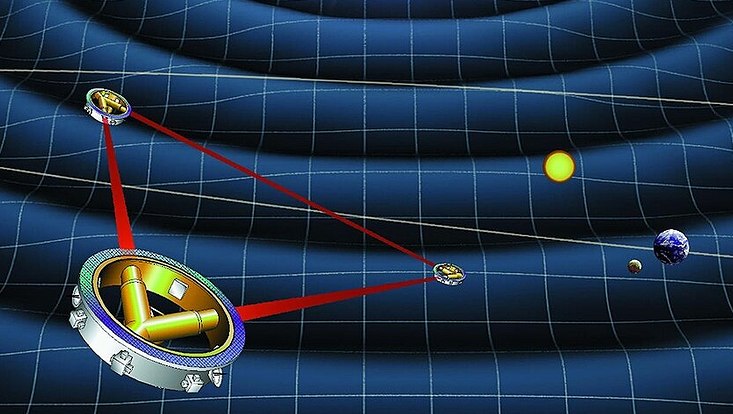31 January 2024
ESA space missionUniversität Hamburg Involved in LISA Observatory Development

Photo: NASA
The LISA space observatory is a giant project of the European Space Agency (ESA) in collaboration with the National Aeronautics and Space Administration (NASA) in the USA. Starting in the mid-2030s, the researchers will set out to detect gravitational waves at previously unresearched frequencies from 0.1 millihertz to one hertz with an innovative measurement device.
Gravitational waves are ripples in the space-time fabric that travel at the speed of light. Low frequency gravitational waves are caused by the merger of supermassive black holes which can be millions of times the mass of our sun. They cannot be detected from Earth due to environmental disturbances such as seismic activities or local vibrations. LISA will thus operate in space. The observatory will consist of 3 identical satellites. Gravitational waves traveling through the Universe cause changes in distance. LISA will measure these changes.
“LISA will be one of the largest and most fascinating measuring instruments ever built by humans, and it will most likely provides us with groundbreaking new insights about the structure and formation of the Universe,” says Prof. Dr. Oliver Gerberding, leading scientist at the University’s Cluster Of Excellence Quantum Universe. In cooperation with the Deutsches Elektronen-Synchrotron (DESY) the research group leader and his team are developing measuring systems for the detection of gravitational waves.
“The completion of the planning phase is an important project milestone. The ESA has reviewed the whole concept—from the definition of the overall mission to the future construction of required hardware. They hence confirmed that the implementation can begin. This means, we will actually start building now,” says Prof. Dr. Thomas Kupfer, who is also a researcher at Universität Hamburg’s Cluster of Excellence Quantum Universe. His research group focuses on binary star systems, which can be detected with electromagnetic waves or gravitational waves at LISA frequencies. The investigation of binary stars is to provide information about the evolution and fate of stars.
A third research group under the leadership of Prof. Dr. Géraldine Servant, deputy spokesperson for the Cluster of Excellence Quantum Universe, will examine so-called primordial gravitational waves. These evolved shortly after the Big Bang. “The new observatory will be particularly sensitive to gravitational waves sent out at the dawn of the Universe. LISA thus opens up completely new possibilities in physics research, which could allow us to investigate the ultrahigh energy scales that dominated the Universe a fraction of a nanosecond after the Big Bang,” says Prof. Servant.
A great variety of institutions and research organizations around the globe are collaborating within the international LISA consortium. Universität Hamburg—University of Excellence and DESY have hugely expanded their involvement in LISA via the Cluster of Excellence Quantum Universe. Hamburg has thus become an important hub of LISA development and scientific use.
